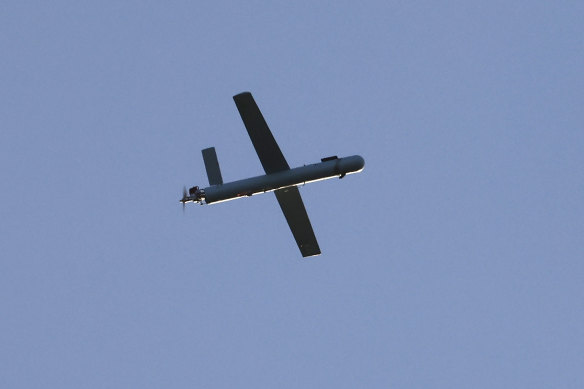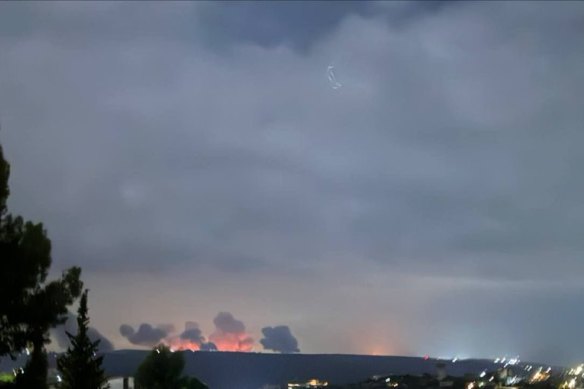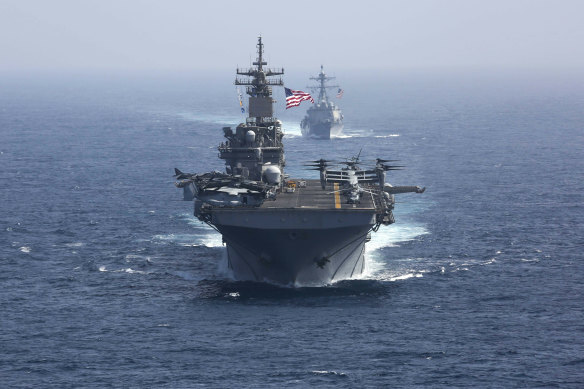Israel’s military spokesperson, Rear Admiral Daniel Hagari, said about 100 Israeli planes struck 270 targets, 90 per cent of them rocket launchers aimed at northern Israel.
He said they were investigating the percentage of incoming rockets and drones intercepted but said the “vast majority” were thwarted.

This photo taken from a position in northern Israel shows a Hezbollah drone over north Israel during the exchange.Credit: AFP
What targets were hit
Israel and Hezbollah said they aimed only at military targets. Israel said no military target was hit, but one soldier with its navy was killed and two others were wounded either by an interceptor for incoming fire, or by shrapnel from one. Two Hezbollah fighters and a militant from an allied group were killed, the groups said.
Israeli Prime Minister Benjamin Netanyahu said the military eliminated thousands of rockets that were aimed at northern Israel and shot down drones heading for the centre of the country.
“I repeat — this is not the end of the story,” he added.
Flights diverted as air raid sirens wail
Air raid sirens were reported throughout northern Israel, and Israel’s international airport closed and diverted flights for about an hour. Israel’s Home Front Command later lifted restrictions in most areas.
Hezbollah said its attack involved more than 320 Katyusha rockets aimed at multiple sites in Israel and a “large number” of drones.
Israel’s military said its intelligence base near Tel Aviv wasn’t hit. Lieutenant Colonel Nadav Shoshani, an Israeli military spokesman, said an initial assessment showed “very little damage” in Israel.
Loading
How likely is an all-out war?
Sunday’s exchange of fire did not set off a long-feared war, and the heavy firepower and lack of civilian casualties might allow both sides to claim a sort of victory and step back. But tensions remain high.
Hezbollah began firing rockets and drones at Israel shortly after the outbreak of the war in Gaza, which was triggered by Hamas’ surprise attack into Israel on October 7. Hezbollah and Hamas are allies, each backed by Iran. Israel has responded with airstrikes, and the near-daily exchanges have escalated in recent months.
More than 500 people have been killed in Lebanon by Israeli strikes since Oct. 8, most of them fighters with Hezbollah and other armed groups but also more than 100 civilians and noncombatants. In northern Israel, 23 soldiers and 26 civilians have been killed by strikes from Lebanon. Tens of thousands of people have been displaced on both sides of the tense border.
Israel has vowed to bring quiet to the border to allow its citizens to return to their homes. It says it prefers to resolve the issue diplomatically through US and other mediators but will use force if necessary. Hezbollah officials have said the group does not seek a wider war but is prepared for one.
What would a full-blown war look like?
Israel and Hezbollah fought a monthlong war in 2006 that left much of southern Beirut and southern Lebanon in ruins, and drove hundreds of thousands of people from their homes on both sides.
Everyone expects any future war to be far worse.

An image showing the airstrikes by Israel on Hezbollah targets in southern Lebanon that was shared on social media.Credit: https://x.com/sentdefender
Hezbollah has an estimated 150,000 rockets and is capable of hitting all parts of Israel. It has also developed an increasingly sophisticated fleet of drones and has been experimenting with precision-guided missiles. A full-scale war could force hundreds of thousands of Israelis to flee, paralyse the Israeli economy and force the army, which is still engaged in Gaza, to fight on two fronts.
Israel has vowed a crushing response to any major Hezbollah attack that would likely devastate Lebanon’s civilian infrastructure and economy, which has been mired in crisis for years. Beirut’s southern suburbs, and towns and villages across southern Lebanon, where Hezbollah’s main strongholds are located, would likely be flattened.
An Israeli ground invasion to root out Hezbollah could drag on for years.
The militant group is far more advanced and better-armed than Hamas in Gaza, which is still putting up a fight after 10 months of intense Israeli bombardment and ground manoeuvres.
Would a war draw in others?
An all-out war between Israel and Hezbollah could spiral into a region-wide conflict.
Iran is a patron of Hezbollah, Hamas and other militant groups in Syria, Iraq and Yemen. Iran has vowed to carry out its own retaliatory strike over the killing of Hamas’ top leader, Ismail Haniyeh, in a blast in its capital last month that was widely blamed on Israel. Israel has not said whether it was involved.
Iran-backed groups across the region have repeatedly attacked Israeli, US and international targets since the start of the war in Gaza and could ramp them up in a bid to take pressure off Hezbollah.
The United States, meanwhile, has pledged ironclad support for Israel and moved a vast array of military assets to the Middle East in recent weeks to try and deter any retaliatory strike by Iran or Hezbollah. The USS Abraham Lincoln recently joined another aircraft carrier strike group in the region.
A US-led coalition helped shoot down hundreds of missiles and drones fired by Iran toward Israel in April in response to an apparent Israeli strike in Syria that killed two Iranian generals.
Both sides downplayed an apparent Israeli counterstrike on Iran, and tensions gradually subsided.
What does this mean for Gaza?
The United States, Egypt and Qatar have spent months trying to broker an agreement for a cease-fire in Gaza and the release of scores of hostages held by Hamas. Those efforts have gained urgency in recent weeks, as diplomats view such a deal as the best hope for lowering regional tensions.

The USS Abraham Lincoln had been deployed to the region.Credit: AP
Hezbollah has said it will halt its attacks along the border if there is a cease-fire in Gaza. It’s unclear whether Hezbollah or Iran would halt or scale back their threatened retaliatory strikes over the killing of Shukur and Haniyeh, but neither wants to be seen as the spoiler of any cease-fire deal.
Despite the intense diplomacy, major gaps remain, including Israel’s demand for a lasting presence along two strategic corridors in Gaza, a demand rejected by Hamas and Egypt. High-level talks were held in Egypt on Sunday.
